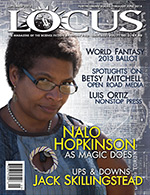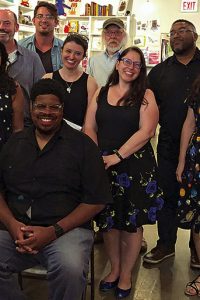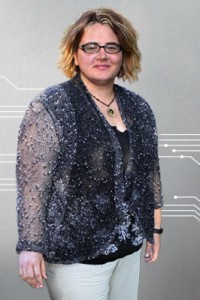Spotlight on: Betsy Mitchell of Open Road Media
 Betsy Mitchell has been a New York science fiction/fantasy editor for more than 30 years, including stints at Baen, Warner, Bantam, and ten years as VP/editor-in-chief of Del Rey. She received the World Fantasy Award for co-editing the anthology Full Spectrum 4, and has published William Gibson, Octavia Butler, Terry Brooks, Peter F. Hamilton, and Naomi Novik, among other authors too numerous to count. She currently runs her own business, Betsy Mitchell Editorial Services, and is strategic advisor for SF/fantasy at digital publisher Open Road Integrated Media, where she is building a list of classic genre titles.
Betsy Mitchell has been a New York science fiction/fantasy editor for more than 30 years, including stints at Baen, Warner, Bantam, and ten years as VP/editor-in-chief of Del Rey. She received the World Fantasy Award for co-editing the anthology Full Spectrum 4, and has published William Gibson, Octavia Butler, Terry Brooks, Peter F. Hamilton, and Naomi Novik, among other authors too numerous to count. She currently runs her own business, Betsy Mitchell Editorial Services, and is strategic advisor for SF/fantasy at digital publisher Open Road Integrated Media, where she is building a list of classic genre titles.I hadn’t been looking for any kind of job when I took early retirement. My plan had been to work with private clients, of whom there are many in this new age of self-publishing (and I still do that, just half as much as I’d anticipated I would). I went in to Open Road just to hear what they had in mind and became seduced by the possibilities of ‘‘publishing backlist as if it were frontlist,’’ which is what Open Road is proud to do. In traditional publishing, it had become frustrating over the past decade or so not to be able to put marketing efforts toward backlist titles, especially if the author had happened to move to another house. All available budget had to go to the frontlist, leaving scores of excellent backlist books languishing in obscurity. At Open Road, I saw what focused marketing could do to introduce old books to new readers, and agreed to come on as a strategic advisor. It’s been 18 months now and things are going strong.
Open Road describes itself as ‘‘360 degree publishing’’ – what does that mean? Does the company have a mission statement, or is there a particular niche you aim to fill?
What we do is match up book fans with authors they may not know but will very likely enjoy, using every means of finding readers available to the modern online marketer. The process is so different from what I learned in pre-internet times! Back then we defined the largest audience – ‘‘female fantasy readers,’’ for example – and bought some print advertising and sent out galleys for review. With the tools available now it’s possible to make our books visible to numerous niche communities – ‘‘cat lovers who also read fantasy,’’ or ‘‘popular science readers who occasionally pick up a novel.’’ Open Road has developed a proprietary online marketing platform that reaches as many of these niche communities as possible in search of new readers for our authors. We invite our authors to supply content from their archives – photos, essays, poems, short stories, etc. – that we use to create interesting pieces that we send to blogs, websites, and social media. It’s not enough just to make digital content available – you’ve got to help readers find it.
How do the multimedia elements Open Road embraces partner with the e-book publishing aspects?
Open Road employs professional film teams across the country and even in the UK to film our authors talking about themselves, their work, and various topics of interest to SF/fantasy fans. Then we slice and dice the results to create gorgeous two-minute pieces on such topics as women in science fiction, or space exploration, or post-apocalyptic fiction, etc., and make those ‘‘mash-ups’’ available to any online site that would like to post them. Watchers can click straight from the videos to buy copies of books by the authors they’ve just watched. We had a film team at Readercon in July and got seven authors on tape during a single weekend!
How are things going now? How many books are you publishing each year, and what recent titles are you especially excited about?
My first year at Open Road was all knocking on doors and making promises, but as word spreads among authors and agents that Open Road’s marketing results in quite satisfying sales, more and more people are coming to us. We have close to 30 authors and more than 150 titles now. We started with Octavia Butler, and she’s certainly a star of the list. I was completely delighted to bring in Theodore Sturgeon’s novels in digital form. We’ve just brought back Ian McDonald’s early work, which had been unavailable even as his career is on the upswing. It’s been great to sign up people I’d never worked with previously – Allen Steele, Tim Powers, James Morrow, Liz Hand, Jonathan Carroll – and to republish some authors I had the pleasure of editing in print – Buzz Aldrin, Sarah Zettel, Kate Elliott, Robert Silverberg, and more.
Some see the rise of e-books and the collapse of mass-market paperbacks as a disaster, others as an opportunity, and still others as something in between. What’s your take?
I do worry about the ecosystem. As print runs fall, unit costs on print titles rise, and the expense of warehousing and shipping must be borne by smaller sales. So for traditional publishers it’s a very great challenge to maintain the ‘‘old ways,’’ even taking into account increased e-book income. For authors, the rise of digital publishers and self-publishing is a great opportunity to finally get one’s work out to potential fans. Yet with the proliferation of (often sub-par) books clogging the digital shelves, an author either needs to know how to make him/herself stand out or to find a publishing partner who can make that happen. The self-publishing success stories I’ve spoken with take the new situation for granted and have figured out how to navigate this brave new world.







